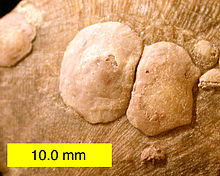- Craniidae
-
Craniidae
Temporal range: Ordovician–Recent
Petrocrania brachiopods attached to a strophomenid brachiopod; Upper Ordovician of southeastern Indiana. Scientific classification 
Kingdom: Animalia Phylum: Brachiopoda Class: Craniata Order: Craniida
Waagen, 1885Suborder: Craniidina
Waagen, 1885Superfamily: Cranioidea
Menke, 1828Family: Craniidae
Menke, 1828Genera 4 living and numerous fossil, including:
†Ancistrocrania
†Crania
Craniscus
†Danocrania
†Isocrania
Neoancistrocrania
Novocrania
ValdiviathyrisSynonyms Craniacea (superfamily)[verification needed]
Valdiviathyrididae (family)
The Craniidae are a family of brachiopods (lamp shells). They are the only members of the order Craniida and the monotypic suborder Craniidina and superfamily Cranioidea; consequently, the latter two taxa are presently redundant and not used very often. Valdiviathyris and Neoancistrocrania were sometimes separated in a family Valdiviathyrididae but this has turned out to be unjustified[1].
Most Craniidae are long-extinct forms known only from fossils like all other Craniforma. However, some 20 species of this 470-million-year-old lineage are extant today. They include Valdiviathyris quenstedti which has remained essentially unchanged for the last 35 million years or so. Although some minimal evolution would obviously have taken place in the meantime, this was essentially silent mutations and marginal adaptations to cooler habitat. Present-day Valdiviathyris are all but inseparable from those of the Late Eocene and the genus cannot even be divided into chronospecies. Thus, V. quenstedti is a true living fossil and one of the oldest and most long-lived species known to science.[1]
Footnotes
References
- Robinson, Jeffrey H. & Lee, Daphne E. (2007): The Recent and Paleogene craniid brachiopod, Valdiviathyris quenstedti Helmcke, 1940. Systematics and Biodiversity 5(1): 123–131. doi:10.1017/S1477200006002179 (HTML abstract)

This brachiopod-related article is a stub. You can help Wikipedia by expanding it.
